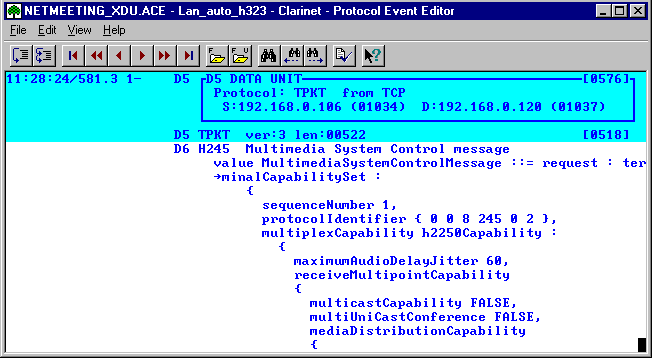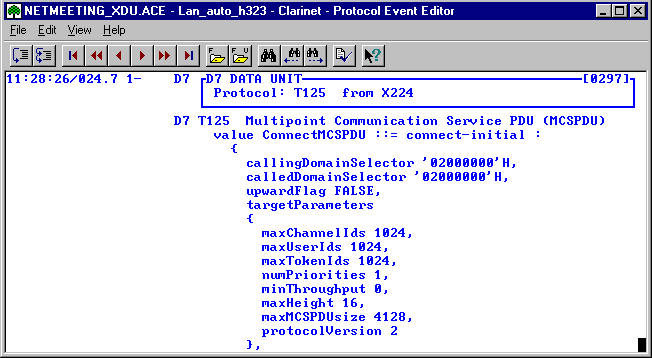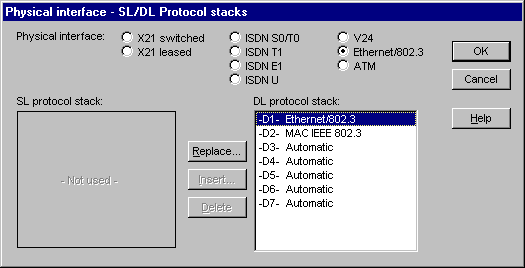Clarinet VOIP: Monitoring H323
From the version 10.1(delivered Feb 2000), the Clarinet Run-Time package includes full
monitoring of Voice-Over IP H323 protocol.
The Clarinet Run-time includes Monitoring of IP protocol over different
types of interfaces (Ethernet, E1/T1, ATM, Vseries). New functions have
been added to support the decoding of protocols specified in the
H323 specification.
The H323 specification is an umbrella recommendation from the International
Telecommunication Union for multimedia communication over Networks (mainly LAN) which
don't provide a Quality of Service. These Networks include IP protocols over different
types of interfaces (such as Ethernet and LAN).

The Clarinet Event-Editor displays events generated from analysis over the Ethernet
interface 802.3.
It includes the three lower layers of protocols. The Layer 2 provides the Type (IP=0800) of
Upper layer protocol.

The Clarinet Filter enables the automatic generation of 'protocol events'
resulting from decoding/concatenation of IP layer events. The TCP protocol is identified
in the IP layer (Pro=06)
The screen below displays TCP events: header is fully decoded, data is displayed in hex
format.
The Clarinet Filter defined for H323 protocols, automatically generates the TPKT
'protocol events' resulting from decoding/concatenation of TCP.
The TPKT events are decoded according to the rules of the RFC1006 protocol
structure which uses a simple packetization scheme in order to delimit TPDUs.
The PDUs are decoded at the highest level according to the H225 protocol
structure:

The Clarinet Filter defined for H323 protocols, automatically generates the TPKT
'protocol events' resulting from decoding/concatenation of TCP.
The TPKT events are decoded according to the rules of the RFC1006 protocol
structure which uses a simple packetization scheme in order to delimit TPDUs.
The PDUs are decoded at the highest level according to the H245 protocol structure.

The Clarinet Filter defined for H323 protocols automatically generates the TPKT
'protocol events' resulting from decoding/concatenation of TCP.
The TPKT events are decoded according to the rules of RFC1006 protocol structure
which uses a simple packetization scheme in order to delimit TPDUs.
The PDUs are decoded at the highest level according to the X224 protocol structure

The Clarinet Filter defined for H323 protocols, automatically generates the T125
'protocol events' resulting from decoding/concatenation of Transport Level X224.
The T125 events are decoded according to the rules of the ITU T125 protocol
structure

The Clarinet Filter enables the automatic generation of 'protocol events'
resulting from decoding/concatenation of IP layer events. The UDP protocol is identified
in the IP layer (Pro=17)
The screen below displays UDP events: header is fully decoded, the upper layer of
protocol over UDP (RTP/RTCP) are decoded.

The Clarinet Filter enables the automatic generation of 'protocol events'
resulting from decoding/concatenation of IP layer events. The UDP protocol is identified
in the IP layer (Pro=17)
The screen below displays UDP events: header is fully decoded, the upper layers of
protocol over UDP (RTP on the below screen) are decoded.
The RTP carries the voice stream in the payload field. The header includes the fields
defined in the RTP standard.

| The Clarinet Filter uses automatic detection of the protocol on all the layers
above MAC. |
 |
| 
